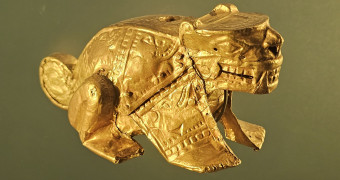There are many factors which influence our health and well-being, including, for example, when and where we were born, our family circumstances, our genetics, behaviours, social settings and economic circumstances. How these interact with environmental factors, including biodiversity and the ecosystems services it provides, is similarly influenced by human cultures.
Culture is the essence of being human - it defines us as a species, as communities, and as individuals. It represents a collective identity, provides the framework for communication, social cohesion and interaction, for learning, and knowledge exchange. It shapes our values, informs our worldviews, and offers us meaning, purpose and a sense of belonging. It provides the means of expressing ourselves and our ideas, and serves as a source of inspiration and innovation.
Culture has a profound impact on our health. Not only does it shape norms and behaviours, it also mediates our relationship with the environment around us and effects how we view, interact with, care for and obtain benefit from biodiversity and ecosystem services.
Importantly, biodiversity is also the essence of culture. The intimate connections between biodiversity and culture have shaped our societies since the beginning of human history. Symbolism, mythologies, and forms of communication have for thousands of years been shaped by our experience of the natural world. This is evident in oral and written histories, folklore, placenames, art and craftwork, music and dance, traditional knowledge systems, cultural observances and languages all over the world. Indeed, the diversity of culture is strongly associated with the diversity of nature. These intimate connections, known together as biocultural diversity, have an important effect on our well-being. Research in anthropology and linguistics has shown that cultural diversity, language diversity and biological diversity often co-occur, to the extent that some work suggests that they have co-evolved, with experience of biodiversity being a driver for language diversification and emergence of distinct knowledge systems. Linguistic diversity is often used as an indicator of biocultural diversity.
Cultural Service category | Description of links to human well-being |
Cultural diversity | Biological diversity is an important factor influencing the diversity of cultures. |
Spiritual and religious values | Many religions attach spiritual and religious values to certain species, habitats, ecosystems, landforms or landscapes. |
Knowledge systems (traditional and formal) | Biodiversity influences and shapes the types of knowledge systems developed by different cultures, including those important to food and nutrition and traditional medicinal knowledge. It is also vital to scientific and technological development. |
Educational values | Ecosystems and their components and processes provide the basis for both formal and informal education in many societies, from traditional forms of subsistence to modern education in health, food systems and business. |
Inspiration | Ecosystems provide a rich source of inspiration for art, folklore, national symbols, architecture, and advertising. |
Bequest, intrinsic and existence values | The benefits, often reflected as a sense of well-being, of simply knowing that species, habitats and / or ecosystems exist, and will continue to exist, even if never utilised or experienced |
Aesthetic values | Many people find beauty or aesthetic value in various aspects of biodiversity, as reflected in the growing interest in nature connectedness, support for parks, scenic drives, and the selection of housing locations. |
Social relations | Ecosystems influence the types of social relations that are established in various cultures. Fishing societies, for example, differ in many respects in their social relations from nomadic herding or agricultural societies. |
Sense of place | Many people value the “sense of place” that is associated with recognised features of their environment, including aspects of the ecosystem. |
Cultural heritage values | Many societies place high value on the maintenance of either historically important landscapes (“cultural landscapes”) or culturally significant species, habitats or ecosystem services. |
Recreation and ecotourism | People often choose where to spend their leisure time based in part on the characteristics of the natural or cultivated landscapes in a particular area; this can further relate to sense of place or identity, nature connectedness, inspiration, aesthetic values, and / or heritage values. |
Table: Connections between cultural ecosystem services and human well-being. Cohab Initiative, adapted from Millennium Ecosystem Assessment, 2003
Culture is constantly informed and transformed by our experiences with nature, and by the associated knowledge systems which migrate with people across the globe. For example, the experience of colonial Europeans in the Americas led to the introduction of novel food species, such as potatoes, chilies and tomatoes, to European, African and Asian food systems, of which they are now considered an integral part. Similarly, in the Americas we can see how the African biocultural heritage of enslaved peoples, from folklore and music to language and food ways, has influenced culture across the continents.
From the perspective of biodiversity conservation, biocultural diversity can be a vital element of sustainable development, with local ecological knowledge, traditions and perspectives being central to local strategies for ecological resilience. These strategies can focus on the agrobiodiversity of food resources and the management of associated ecosystems, on specific cultural keystone species (species that greatly influence the cultural identity of a people, including species important for food, medicine or spiritual practices), on sacred natural sites, or on traditional systems of observing and managing the physical landscape. This means that the stewardship of indigenous peoples and local communities is often the key to effective strategies for the conservation and sustainable use of biodiversity.
The loss of elements of biodiversity can have a significant negative impact on culture and cultural well-being, which can threaten physical, emotional and social health. Biodiversity loss can affect core aspects of cultural heritage, impacting on language and other forms of expression, whilst eroding sense of place and identity. Where species loss or ecosystem degradation affects the abundance of cultural keystone species, transforms unique landscapes, or negates core elements of traditional knowledge such as food and medicinal practices, the sense of loss and dislocation from heritage can have significant impacts on mental well-being and social cohesion. Owing to their locally specific and often unique relationships with biodiversity, indigenous peoples and local communities are disproportionately affected by such impacts.
For the health sector, the increasing scale of tourism and migration has created a need for greater cultural competence in health care systems. This means that all levels of health policy and practice - including the delivery of primary care, the coverage of health insurance, and the nature of prescription and intervention - must be attuned to the the influence of culture on attitudes, beliefs and behaviours, including the relationship between people and their local biodiversity and ecosystem services. The development of health services and delivery of health care at the community level is generally organised around predominant local cultural norms, but must also increasingly account for cultural diversity and the cultural characteristics of minority groups.





